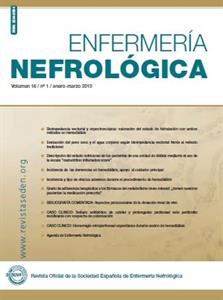Contenido del artículo principal
Resumen
Introducción: La bioimpedancia eléctrica se puede utilizar para establecer el estado de hidratación y nutrición en hemodiálisis. La valoración del estado de hidratación de los pacientes se hace habitualmente a modo de “arte clínico” mediante el concepto de “peso seco”. Existen pocos trabajos que estudien la concordancia entre el peso seco estimado de forma clínica y el deducido post-bioimpedancia. Material y métodos: Se estudiaron 36 pacientes (26 varones y 10 mujeres). Se realizó bioimpedancia eléctrica vectorial antes y 30’ después de diálisis de mitad de semana midiendo, el peso, el agua total y su distribución, el ángulo de fase, la relación de Na/K, y la posición del vector de cada paciente en el normograma de esferas: percentiles 50,75 y 95. El peso-seco se estimó según la valoración subjetiva del nefrólogo, enfermera y paciente. Además en 12 pacientes estables se continuó el análisis por bioim-pedancia durante 4 semanas. Resultados: La edad fue de 69.6±12.5 (r=29-89). Prediálisis el peso fue 73.1±14.1, y postdiá-lisis de 70.4±13.6. El agua corporal total fue de 24.7±2.8 L/m (53.7±8.2% del peso); 22.1±3.0 L (56.2±5.9% del peso) correspondían a agua extracelular y 17.4±3.8 L/m a intracelular. Pos-themodiálisis, el agua total se redujo a 22.8±2.4 L/m (51.8±8.6% del peso) (23.5±2.2 L en varones; y 21,5±3 L en mujeres) de los que 19.6±2.5 L (54,3±5.8% del peso) correspondían a agua extra-celular y 16.7±3.3 a agua intracelular. Un varón y 5 mujeres sobrepasaron el valor de referencia más alto. El peso posthemodiálisis fue 70,4±13,6 superior al peso seco establecido: 70,2±13,4 (p=0,02).
Palabras clave
Detalles del artículo
Derechos de autor 2013 María Teresa Tristán, Mª Luisa Garcinuño Martín, Reyes González de Antonio, Elvira Roig Gaspar, Daniel Corbacho Barrenechea

Esta obra está bajo una licencia internacional Creative Commons Atribución-NoComercial 4.0.
Aviso de derechos de autor/a
© Los autores ceden de forma no exclusiva los derechos de explotación de los trabajos publicados y consiente en que su uso y distribución se realice con la Licencia Creative Commons Atribución - No comercial 4.0 Internacional (CC BY-NC 4.0). Puede consultar desde aquí la versión informativa y el texto legal de la licencia. Esta circunstancia ha de hacerse constar expresamente de esta forma cuando sea necesario.
Referencias
- Piccoli A, para Itailan Hemodialysis-Bioelectrical Impedance Analysis Study Group. Identifi cation of operational clues to dry weight prescription in hemodialysis using bioimpedance vector analysis. Kindey Int 53: 1036-1043,1998.
- Cigarrán S, Barril G, Cirugeda A, Herraiz I, Selgas R. Evaluación del estado nutricional de los pacientes renales y ajustes del peso seco en HD: papel de la Bioimpedancia. Electron J Biomed. 2004;1:16-23.
- Chen YC, Chen HH, Yeh JC, Chen SY. Adjusting the dry weigth by extracellular volume and body composition in hemodialysis patients. Nephron. 2002; 92(1):91-6.
- Chertow G. Lazarus JM, Lew NL, Lihong MA, Lowrie EG. Bioimpedance norms for hemodialysis population. Kidney Int. 1997;52:1617-1621.
- Hoffer EC, Meador CK, Simpson DC. Correlation of whole-body impedance with total body water volume. J.A ppl. Physiol. 1969;27:531-534.
- Arias M. La bioimpedancia como valoración del peso seco y el estado de hidratación. Dial Traspl. 2010; 31(4).137-9.
- Vasko R, Müller GA, Ratliff BB, Jung K, Gaucczinski S, Koziolek MJ. Clinical judgment is the most important element in overhydration assessment of chronic hemodialysis patients. Clin. Exp. Nephrol. 2012, Nov 29 [DOI 10.1007/s 10157-012-0745-9].
- Liu L, long G, Ren J, Li J, Xu J, lei J, Li M, Qiu M, Yuan P, Sun W, Lin S, Liu W, Sun Y, Ma Y, Mao Y, Shen Y, Zuo L. A randomized control-led trial of long term effect of BCM guided fluid management in MHD patients (BOCOMO study): rationales and study design. BCM Nephrol. 2012, 13:120-7.
Referencias
Piccoli A, para Itailan Hemodialysis-Bioelectrical Impedance Analysis Study Group. Identifi cation of operational clues to dry weight prescription in hemodialysis using bioimpedance vector analysis. Kindey Int 53: 1036-1043,1998.
Cigarrán S, Barril G, Cirugeda A, Herraiz I, Selgas R. Evaluación del estado nutricional de los pacientes renales y ajustes del peso seco en HD: papel de la Bioimpedancia. Electron J Biomed. 2004;1:16-23.
Chen YC, Chen HH, Yeh JC, Chen SY. Adjusting the dry weigth by extracellular volume and body composition in hemodialysis patients. Nephron. 2002; 92(1):91-6.
Chertow G. Lazarus JM, Lew NL, Lihong MA, Lowrie EG. Bioimpedance norms for hemodialysis population. Kidney Int. 1997;52:1617-1621.
Hoffer EC, Meador CK, Simpson DC. Correlation of whole-body impedance with total body water volume. J.A ppl. Physiol. 1969;27:531-534.
Arias M. La bioimpedancia como valoración del peso seco y el estado de hidratación. Dial Traspl. 2010; 31(4).137-9.
Vasko R, Müller GA, Ratliff BB, Jung K, Gaucczinski S, Koziolek MJ. Clinical judgment is the most important element in overhydration assessment of chronic hemodialysis patients. Clin. Exp. Nephrol. 2012, Nov 29 [DOI 10.1007/s 10157-012-0745-9].
Liu L, long G, Ren J, Li J, Xu J, lei J, Li M, Qiu M, Yuan P, Sun W, Lin S, Liu W, Sun Y, Ma Y, Mao Y, Shen Y, Zuo L. A randomized control-led trial of long term effect of BCM guided fluid management in MHD patients (BOCOMO study): rationales and study design. BCM Nephrol. 2012, 13:120-7.




